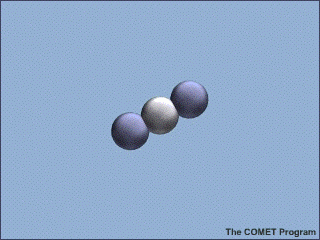justoffal
Diamond Member
- Jun 29, 2013
- 33,620
- 26,346
- 2,905
CO2 does not just absorb at 15 microns !!!! And whatever it absorbs it re-emits in all directions.Only when the concentration of the radiative gas is so rare that it loses the capacity to reabsorb the radiation does the gas start losing energy by escape to space.CO2 blocks nothing...it absorbs and immediately emits whatever it has absorbed assuming that it doesn't lose the energy to collision with another molecule first...a very large assumption since so few ghg molecules actually get to emit the energy they absorbed.. The only time a ghg molecule might block IR is after it has reached its equilibrium temperature...at roughly -80F...till then, it absorbs and emits if it has the opportunity to emit...it doesn't block anything
You don't understand how blackbody radiation happens in a gas.
Molecular collisions are usually elastic but they can also convert kinetic energy into an excited molecular state, or gain kinetic energy when an excited molecule relaxes.
Even more rarely does an excited molecule actually relax by emitting a photon, which is typically immediately reabsorbed.
The amount of radiation only depends on the temperature of the gas. The percentage of the radiating gas does not matter. More GHG molecules emit more photons but they get reabsorbed faster. The Equipartition Theorum. Only when the concentration of the radiative gas is so rare that it loses the capacity to reabsorb the radiation does the gas start losing energy by escape to space.
How did you come up with this gem? According to you CO2 can trap photons for an indefinite time like some sort of Ghostbuster containment unit.
No 15 micron radiation radiation escapes to space from 100 metres up in the atmosphere. Each and every photon is absorbed by a CO2 molecule before it has returned to the surface or escapes to space. Is that what you mean by a Ghostbuster Containment Unit?
Or are you arguing that there never comes a time were the air is thin enough that some of the 15 micron radiation does not get absorbed by a CO2 molecule and escapes to space?
I have explained what I think happens with CO2 radiation and emission, with the energy that enters at the surface boundary and the energy that leaves at the 'emission height'.
Feel free to grace us with monumental knowledge and explain what really happens.
Why would it be different from any other gas that absorbs light and re-emits it..
But I don`t care what you or the other armchair experts believe, who never had any hands on experience or formal education in that field.
Feel free to grace us with monumental knowledge
Quit trying to be a smart-ass the only thing monumental here is the stupidity of your statement.
Lol...I feel your pain. I have been at the trade
For thirty years dealing directly with
Heat transfer including the aqueous
Contaiment of Co2 at various energy levels
and temperatures. From the very beginning of this debate some thirty years ago I always
Marveled at the sudden appearance of
Multiple experts pontificating about the utterly ludicrous. I have always wondered how anyone could possibly know whether
the atmospheric concentrations caused the warming or the warming caused the atmospheric concentrations since both are equally likely. Yet they always seemed to be so certain that I assumed I must simply be lacking in the appropriate knowledge of the matter. Then it occurred to me one day whilst Conversing with a Psuedo climatologist/expert about skinny Polar bears that these people aren't experts in anything but opinion, that they have an abundance of.
Regards:
Jo
